SBAA534 March 2022 ADC128S102-SEP , ADC128S102QML-SP , ADS1278-SP , ADS1282-SP , LF411QML-SP , LM101AQML-SP , LM111QML-SP , LM119QML-SP , LM124-SP , LM124AQML-SP , LM136A-2.5QML-SP , LM139-SP , LM139AQML-SP , LM148JAN-SP , LM158QML-SP , LM185-1.2QML-SP , LM185-2.5QML-SP , LM193QML-SP , LM4050QML-SP , LM6172QML-SP , LM7171QML-SP , LMH5401-SP , LMH5485-SEP , LMH5485-SP , LMH6628QML-SP , LMH6702QML-SP , LMH6715QML-SP , LMP2012QML-SP , LMP7704-SP , OPA4277-SP , OPA4H014-SEP , OPA4H199-SEP , THS4304-SP , THS4511-SP , THS4513-SP , TL1431-DIE , TL1431-SP , TLC2201-SP , TLV1704-SEP
2.3 Linearity or Frequency Response
This section looks at the frequency response of the input circuit to verify that the bandwidth is wide enough to preserve the signal of interest across its entire bandwidth but also be narrow enough to act as an anti-aliasing filter.
For this, the signal chain from signal input to ADC input must be analyzed, in other words, the same circuit as shown in Figure 2-1. Figure 2-8 shows the selection of the AC Transfer Characteristic option in the Analysis menu in the TINA-TI simulator. Use this option to analyze the frequency response for amplitude and phase.
 Figure 2-8 Select AC Transfer
Characteristic to Analyze the Frequency Response of the Input Circuit
Figure 2-8 Select AC Transfer
Characteristic to Analyze the Frequency Response of the Input Circuit Figure 2-9 AC Transfer Characteristic of
Analog Front End – 3 dB Bandwidth of VOUTdiff is 542.96 kHz
Figure 2-9 AC Transfer Characteristic of
Analog Front End – 3 dB Bandwidth of VOUTdiff is 542.96 kHzFor the lower frequencies, the gain is stable at –12.04 dB. The –3-dB bandwidth (–15.04 dB) shows at 542.96 kHz, see Figure 2-9. This is very well above the cutoff frequency of 60 kHz of the digital filter response of the ADS1278. The linearity requirement for the bandwidth of interest is clearly met.
The second concern is on aliasing. ADS1278-SP is a sigma-delta modulator. In this example, the device modulates the signal with 8.192 MHz. Accordingly, Nyquist is at fmod / 2 = 4.096 MHz. The gain shows –57 dB at that frequency which means only 45-dB suppression at the Nyquist frequency. The result from simulation is an indication that further measures for suppression of frequencies at and above 4 MHz might be required.